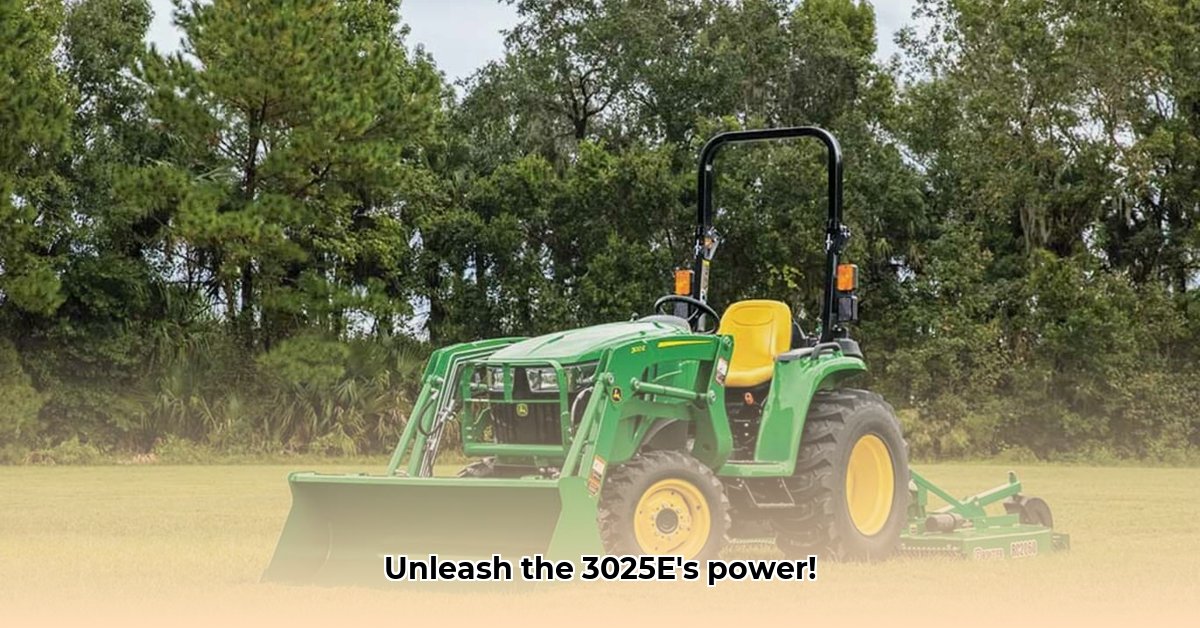
3025E Tractor: A Detailed Technical Review
The John Deere 3025E compact utility tractor offers a compelling blend of power, fuel efficiency, and safety features. This review examines its key components, performance characteristics, and long-term maintenance considerations to provide a comprehensive understanding for prospective buyers. For more information on John Deere's hybrid technology, check out this page.
Engine and Emissions System: Performance and Environmental Responsibility
The 3025E boasts a Yanmar 3TNV88F-EPJT1 diesel engine producing 24.4 horsepower. Its common rail system (CRS) precisely controls fuel injection, maximizing power while minimizing fuel consumption. This translates to significant cost savings over the tractor's lifespan. How much can you save on fuel? Real-world data from independent tests is necessary to provide exact figures.
The integrated exhaust after-treatment system is a key environmental feature. It consists of a diesel particulate filter (DPF) and a diesel oxidation catalyst (DOC) that drastically reduce emissions. The system employs three regeneration methods: passive, active, and parked. While this system minimizes environmental impact, it necessitates understanding the long-term implications for maintenance costs. Regular active and parked regeneration cycles, and the eventual need for DPF ash removal, are factors to consider in the overall cost of ownership.
Transmission and Drivetrain: Smooth Operation and Enhanced Traction
The 3025E's hydrostatic transmission (HST) system, utilizing Twin Touch™ foot pedals, allows for seamless speed and direction control. This intuitive system significantly enhances operator comfort, especially during extended use. The integrated differential lock further improves traction on uneven terrain, making it suitable for diverse agricultural applications. Optional cruise control adds another layer of convenience for tasks requiring consistent speed. The Sauer-Danfoss integrated pump and motor are the foundation of this reliable and responsive system. Is the HST system truly more efficient than a geared transmission? Comparative studies are needed to quantify this claim.
Operator Station: Comfort, Safety, and Ergonomic Design
John Deere prioritized operator comfort and safety in the 3025E's design. The adjustable seat minimizes fatigue during long working days. Critically, the tractor incorporates a rollover protective structure (ROPS), offering crucial protection in the event of a rollover. An operator presence system automatically shuts off the engine if the power take-off (PTO) is engaged without the operator in the seat, a vital safety feature. Does the operator presence system meet or exceed industry safety standards? Verification of this claim is essential.
Comparison and Considerations: Weighing the Pros and Cons
| Feature | Advantages | Potential Considerations |
|---|---|---|
| Engine | Fuel-efficient, powerful, advanced emission control | Long-term DPF maintenance and potential ash removal costs. |
| HST | Smooth operation, intuitive control, enhanced traction | Higher initial purchase price compared to some geared transmission tractors. |
| Operator Station | Comfortable, adjustable seat; comprehensive safety features | Subjective operator preferences on control layout might vary. |
| Overall | Versatile, efficient, safe, and user-friendly | Potential for higher maintenance costs over the tractor’s lifetime. |
Minimizing John Deere 3025E DPF Maintenance Costs: A Practical Guide
The 3025E's DPF, while environmentally beneficial, requires proactive maintenance to mitigate long-term costs. Let's examine strategies to minimize these costs.
Understanding the DPF's Role
The DPF traps soot particles, preventing their release into the environment. Regular maintenance is crucial to prevent costly repairs.
Proactive Maintenance Strategies
- Adhere to the recommended service intervals: This prevents minor problems from escalating. Specific intervals are detailed in the owner's manual 1.
- Use quality fluids: Employing the correct engine oil and fuel is vital for DPF and engine health.
- Avoid prolonged idling: Excessive idling increases soot production, stressing the DPF.
Parts Management: OEM vs. Aftermarket Considerations
The availability of specific hydraulic filters (LVA14703 and LVA16054) might present some supply chain challenges. Consider these factors:
- OEM parts: While more expensive upfront, they ensure compatibility and often longer lifespan, reducing long-term expenditures.
- Aftermarket parts: Choose reputable suppliers and verify part numbers meticulously to avoid compatibility issues.
Utilizing Available Resources
- Owner's Manual: Although clarity issues may exist, the owner’s manual (1) provides essential information.
- Online Resources: John Deere's website offers support and troubleshooting guides.
- Dealer Support: Consult your local John Deere dealer for guidance on maintenance and parts.
Extending Oil Change Intervals: A Cost-Benefit Analysis
While the 200-hour/annual engine oil change interval aims at cost savings, consider using high-quality, extended-life oils to potentially lengthen this interval while mitigating environmental impact.
Key Takeaways: Effective long-term management of the John Deere 3025E involves proactive maintenance, diligent parts selection, and leveraging resources for optimal performance and minimized costs.